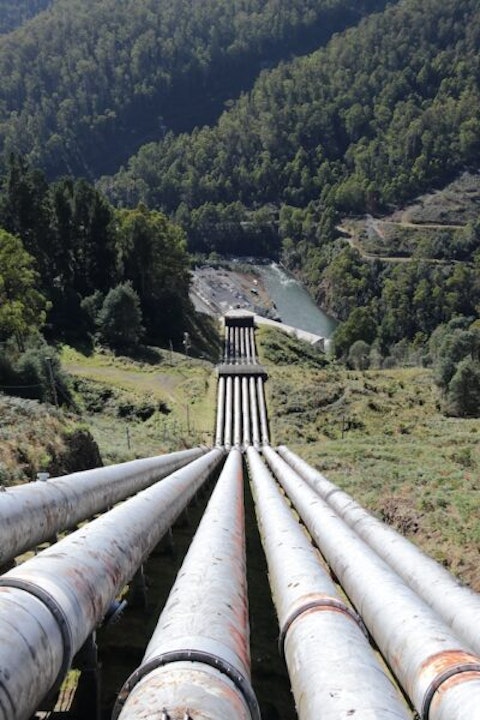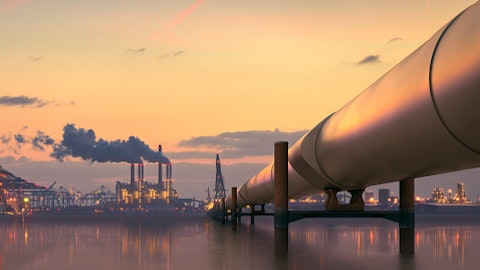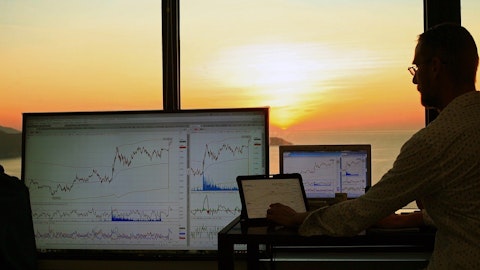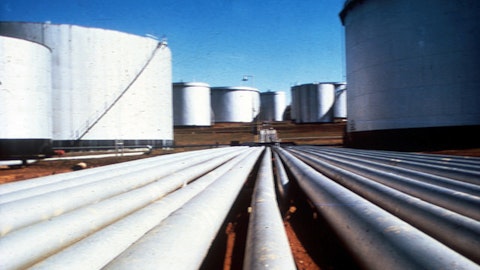Energy Transfer LP (NYSE:ET) Q4 2022 Earnings Call Transcript February 15, 2023
Operator: Good day, and welcome to the Energy Transfer Fourth Quarter and Full Year 2022 Earnings Conference Call. All participants will be in listen-only mode. After today’s presentation, there will be an opportunity to ask questions. Please note this event is being recorded. I would now like to turn the conference over to Tom Long, Co-CEO. Please go ahead.
Tom Long: Thank you, operator, and good afternoon everyone and welcome to the Energy Transfer fourth quarter 2022 earnings call. I’m also joined today by Mackie McCrea and other members of the senior management team, who are here to help answer your questions after our prepared remarks. Hopefully, you saw the press release we issued earlier this afternoon, as well as the slides posted to our website. As a reminder, we will be making forward-looking statements within the meaning of Section 21E of the Securities Exchange Act of 1934. These statements are based upon our current beliefs, as well as certain assumptions and information currently available to us, and are discussed in more detail in our Form 10-K for the full year ended December 31, 2022, which we expect to file this Friday, February 17.
I’ll also refer to adjusted EBITDA and distributable cash flow, or DCF, both of which are non-GAAP financial measures. You’ll find a reconciliation of our non-GAAP measures on our website. I’d like to start today by going over our financial results. For full year 2022, we generated adjusted EBITDA of $13.1 billion, which reflects continued growth over 2021 and is a partnership record. DCF attributable to the partners of Energy Transfer, as adjusted, was $7.4 billion, which resulted in excess cash flow after distributions of approximately $4.4 billion. On an incurred basis, we had excess DCF of approximately $2.4 billion, after distributions of $3.1 billion and growth capital of approximately $1.9 billion. Operationally, we moved record volumes across all of our segments for the year ended 2022, which included record volumes on our legacy midstream, intrastate and NGL transport systems as well as through our fractionators at Mont Belvieu.
In addition, we exported a record amount of NGLs out of our Nederland Terminal in 2022, and we expect our exports to continue to grow into 2023. Looking at our fourth quarter 2022 results, we were pleased to report another strong quarter during which we generated consolidated adjusted EBITDA of $3.4 billion, which was up more than 20% compared to the fourth quarter of 2021. DCF attributable to the partners, as adjusted, was $1.9 billion compared to $1.6 billion for the fourth quarter of 2021. This resulted in excess cash flow after distributions of approximately $965 million. On an incurred basis, we had excess DCF of approximately $360 million after distributions of $945 million and growth capital of approximately $605 million. On January 25, we announced a quarterly cash distribution of $0.305 per common unit or $1.22 on an annualized basis.
This distribution represents a 75% increase over the fourth quarter of 2021 and is a 15% increase over the third quarter of 2022. With this recent increase, we have now restored our distribution level to where it was in the first half of 2020. We greatly appreciate our equity investors, who have supported us over the last two plus years as we have diligently worked to lower our leverage and improve the financial stability of the partnership. This will allow us to better capitalize on opportunities that will lead to the future success for the partnership and all of our stakeholders. Future distribution increases will be evaluated on an annual basis while balancing energy transfers, leverage targets, growth opportunities and potential unit buybacks.
As of December 31, 2022, the total available liquidity under our revolving credit facilities was approximately $4.2 billion. And while we are not speaking directly for the rating agencies, based on our internal calculations, we are now within the 4 to 4.5 target leverage ratio range based on our calculations of the rating agencies leverage ratios. Now turning to our results by segment for the fourth quarter, I’ll start with NGL and refined products. Adjusted EBITDA was $928 million compared to $739 million for the same period last year. This change was primarily due to higher transportation, fractionation and terminal services margins and the recognition of gains on hedged NGL inventory. NGL transportation volumes on our wholly owned and joint venture pipelines increased to a record 2 million barrels per day compared to 1.9 million barrels per day for the same period last year.
This increase was primarily due to higher volumes from the Permian and Eagle Ford regions as well as on our NGL pipelines that deliver into our Nederland Terminal. And our average fractionated volumes set a new partnership record, averaging 962,000 barrels per day compared to 895,000 barrels per day for the fourth quarter of 2021. In fact, during the fourth quarter of 2022, single day fractionation throughput at Mont Belvieu reached more than 1 million barrels for the first time in our partnership’s history. NGL export volumes significantly exceeded fourth quarter and full year 2021 exports, driven by record ethane and LPG exports out of our Nederland Terminal. This was primarily driven by the second tranche of satellites contract going into effect on July 1, which doubled the volume commitments from the initial term.
In 2022, we loaded nearly 43 million barrels of ethane out of Nederland. And for full year 2023, we expect to load more than 60 million barrels. In total, we continue to export more NGLs than any other company or country with our percentage of worldwide NGL exports remaining at approximately 20% of the world market. For midstream, adjusted EBITDA was $632 million compared to $547 million for the fourth quarter of 2021. This was primarily due to increased throughput and all of our operating regions as well as the acquisition of the Enable assets in December of 2021 and the Woodford Express assets in September of 2022. Gathered gas volumes were at a record 19.4 million MMBtus per day compared to 14.8 million MMBtus per day for the same period last year.
Excluding Enable and Woodford Express, gathered gas volumes on our legacy assets were up 8% over the same period last year. For our crude oil segment, adjusted EBITDA was $571 million compared to $533 million for the same period last year. These results were driven by improved performance on our Texas crude pipeline system, increased throughput at our Gulf Coast terminals, stronger refinery utilization and higher export demand as well as the addition of the Enable assets in December of 2021. Crude oil transportation volumes increased to 4.3 million barrels per day compared to 3.8 million barrels per day for the same period last year. This was driven by higher volumes on our Texas pipeline systems and on the Bayou Bridge pipeline, the addition of the Enable assets as well as placing the Ted Collins Link and Cushing South pipelines into service.
In our interstate segment, adjusted EBITDA was $494 million compared to $397 million for the fourth quarter of 2021. This was primarily due to increased transportation revenue related to higher contracted volumes and rates on several of our pipelines as well as the addition of the Enable interstate assets. Volumes increased 33% over the same period last year and utilization on many of our interstate pipelines, including Trunkline, Tiger, FGT, Southeast Supply Header and Rover remains high. And for our intrastate segment, adjusted EBITDA was $433 million compared to $274 million in the fourth quarter of last year. This was primarily due to higher pipeline and storage optimization opportunities, higher fees on assets in the Haynesville as well as the addition of the Enable assets.

Photo by Christian Bass on Unsplash
Utilization of our HPL System remains strong due to the increased demand for our gas takeaway and our Rigs pipeline system continues to flow at or near capacity due to increased activity in the Haynesville. Now looking at recent developments on our ongoing growth projects. I’ll start with an update on our Lake Charles LNG project. Global demand for LNG remained strong as energy security has emerged as a key theme for LNG. In addition, U.S. natural gas producers have shown increased interest in committing a portion of their production to long-term sales arrangements at European and Asian natural gas or LNG index prices. We view these two factors as key drivers towards securing additional long-term LNG offtake agreements. The LNG market along the Gulf Coast is currently extremely competitive.
Given this level of competition, it is taking us longer to reach FID than originally expected, but we are optimistic that we will bring this project to FID. We continue making progress on all aspects of the project and are working hard to sign up more customers, and we’ll share additional information as it becomes available. Turning to our Nederland and Marcus Hook export terminals, in November 2022 we completed dredging at Marcus Hook to increase the depth at one of our docks to 42 feet, which will allow us to fully load VLECs at this dock going forward. In addition, we recently completed a FEED study on a potential expansion project at our Nederland Terminal, which would provide us with additional NGL export capacity. We are currently evaluating next steps and hope to provide more details on this opportunity in the near future.
We also expect to approve an optimization project at Marcus Hook that would add incremental ethane refrigeration and storage capacity. NGL demand, both in the U.S. as well as from overseas customers continues to increase. We are firm believers that there will be significant growth in international demand for many years to come. Next, construction of our Frac VIII continues as scheduled, and we expect it to be in service in the third quarter of 2023. This addition will bring our total Mont Belvieu fractionation capacity to approximately 1.15 million barrels per day. Also during the fourth quarter, we brought a new storage cavern online at Mont Belvieu with a capacity of approximately 3 million barrels, which supports our ongoing purity growth at the fracs as well as growth at our docks in Nederland.
This brings our total underground NGL storage capacity at Mont Belvieu to approximately 60 million barrels. Out in the Permian, in December, we placed our 200 million cubic foot per day Grey Wolf processing plant into service, and it is already ramping up more quickly than anticipated. As a reminder, this plant, which is located in the Delaware Basin, is supported by new commitments and growth from existing customer contracts. Construction continues on the Bear plant, our eighth 200 million cubic foot per day processing plant in the Delaware Basin. This plant remains on schedule to be in service in the second quarter of 2023. In addition, we continue to evaluate the necessity and potential timing of adding another processing plant in the region.
Regarding Permian takeaway, we also recently completed modernization and debottlenecking work on our Oasis pipeline, which added at least an incremental 60,000 Mcf per day of takeaway capacity out of the Permian Basin. We also placed the Gulf Run pipeline into service in December. Gulf Run, which is a 42-inch interstate natural gas pipeline with 1.65 Bcf per day of capacity, provides natural gas transportation between our upstream pipeline network and from the Haynesville Shale for delivery to the Gulf Coast connecting some of the most prolific natural gas producing regions in the U.S. with the LNG export market as well as many markets along the Gulf Coast. It is backed by a 20-year commitment for 1.1 Bcf per day from Golden Pass LNG, and we recently concluded a non-binding open season on Gulf Run due to growing producer demand.
We were pleased with the results of the open season and customer discussions are ongoing, which will likely necessitate additional facilities beyond the initial design of 1.65 Bcf per day. We are already utilizing a significant portion of Zone 1 capacity on Gulf Run, and we have added additional customer commitments through Zone 2, which is being delivered into our Trunkline pipeline. In addition to these ongoing projects, we continue to evaluate and have customer discussions regarding a number of other projects that are over the long-term could provide strong returns and significant upside to our business. We remain optimistic that we can bring these projects to FID and look forward to sharing any significant updates on these potential projects at the appropriate timing.
On the alternative energy front, we continue to make progress on our carbon capture and storage project with CapturePoint. That is related to our North Louisiana processing plants. The Class VI permit for the sequestration side was filed by CapturePoint with the EPA in June of 2022. We also recently executed a letter of intent with Oxy related to Oxy’s Magnolia hub in Allen Parish, Louisiana, north of the Lake Charles Industrial Complex. Pursuant to the letter of intent, Energy Transfer and Oxy are working together to obtain long-term commitments of CO2 from the industrial customers in the Lake Charles, Louisiana area. If this project reaches FID, Energy Transfer would construct a CO2 pipeline to connect the customers to Oxy’s sequestration site in Allen Parish, Louisiana.
Oxy filed applications with the EPA for 2 Class 6 injection wells in 2021. Oxy is a leader in the CCS sector, and we’re pleased to be working with them to make this project successful. In addition, we’re evaluating numerous opportunities to capture and either utilize or store the CO2 across our systems. Now looking at our growth capital spend for the full year of December 31, 2022. Energy Transfer spent approximately $1.9 billion on organic growth projects, primarily in the midstream, interstate and NGL and refined products segments, excluding SUN and USA Compression CapEx. For full year 2023, we expect growth capital expenditures to be between $1.6 billion and $1.8 billion, which will be spent primarily in the midstream NGL and refined products and interstate segments.
This capital includes projects that will address growing demand like Frac VIII at Mont Belvieu, the Bear processing plant in the Permian Basin, compression and optimization projects on existing pipelines, new treating capacity in the Haynesville, additional gathering and compression build-out in the Permian, improved efficiencies and emission reduction work, as well as preliminary spend related to carbon capture projects. In addition, this number does include a small amount of capital that was pushed from 2022 into 2023 due to project in-service timing needs. A significant amount of our 2023 capital spend is comprised of projects that are expected to be online and contributing cash flow before the end of 2023 at very attractive returns. Now for our 2023 adjusted EBITDA guidance, given the continued domestic and international demand for our products and services, the ability of our base business to operate through various market cycles as well as our market outlook for the year, we expect our adjusted EBITDA to be between $12.9 billion and $13.3 billion.
Our business continues to provide stable cash flows and opportunities for optimization and expansion. And in 2023, we expect utilization in all of our core segments to increase. With the current forward curve for commodity prices and spreads, our guidance does not assume the same upside benefits from pricing and spreads that we experienced in 2022. As a result of our commitment to strengthening our balance sheet throughout 2022, we entered 2023 in a much stronger financial position, and we expect to maintain our leverage target range of 4 to 4.5 times. We will continue to place emphasis on strategically allocated cash flow in a manner that best positions us to further improve our financial flexibility and leverage, invest in high-returning growth projects and return value to unitholders.
We remain bullish about the future of our industry and the growing worldwide demand for crude oil, natural gas and natural gas liquids and refined products. As we look for additional ways to address existing and new demand for our products, we will continue to pursue strategic growth projects that enhance our existing asset base and generate attractive returns as part of our capital allocation strategy. This concludes our prepared remarks. Operator, please open the line, up for our first question.
See also Analyst Price Target Revisions and 15 Countries that Produce the Best Beef.
Q&A Session
Follow Energy Transfer Lp (NYSE:ET)
Follow Energy Transfer Lp (NYSE:ET)
Operator: We will now begin the question-and-answer session The first question comes from Jeremy Tonet with JPMorgan. Please go ahead.
Tom Long: Jeremy you are being muted.
Jeremy Tonet: Pardon me.
Operator: Jeremy your line is now live.
Jeremy Tonet: Hi.
Tom Long: Hi, good afternoon.
Jeremy Tonet: That’s helpful to be unmuted. Thank you. Maybe just kind of start off here, I want to go to the Permian and kind of get high-level thoughts as you see it with regards to basin logistic needs and Permian gas takeaway has been in focus. And we’ve seen volatility in Waha prices. I’m just wondering what that means for ET this year, what’s kind of embedded to the guidance. But more so, I guess, longer term, how you see basin egress evolving and future opportunities for ET along these lines, particularly as it relates to possible timing for Warrior development?
Mackie McCrea: Jeremy, this is Mackie. Yes, when we think about the Permian Basin, probably one of the most prolific basins in the world. We love looking at the maps because, as you know, we have inter and intra state pipelines come in every direction and out of that area including three NGL pipelines and then, of course, some significant pipeline capacity across the state. As you know, everybody knows on this call, there has been a significant growth in natural gas volumes out of the Permian. There has been expansions. There continue to be compression expansions on the 42-inch getting built. And then about this time last year, we kicked off Warrior and started getting some momentum and we continue to have momentum. So we don’t know when the next project will be announced coming out of the Permian Basin, we do believe it will be ours when it happens.
Just a quick update on those volumes. We have contracted about 25% to 30% of what we need to get to FID on Warrior. We’re talking to another at least 50% to 60% of what would be needed. It is a slow process based on what you just said, when you’ve got negative spreads where Waha has been higher than Katie and or you’ve got a few cents spread. It’s hard to get deals done. But certainly, over the next three to four years on top of what’s already been expanded and built, there will need to be another line and if there is one, we do believe it will be ours.
Jeremy Tonet: Got it. That’s really helpful. And then kind of looking at the other side gas Downstream, significant LNG development coming in the Gulf Coast, particularly in Louisiana over the balance of the decade here and it seems like you guys have quite the pipeline positioning in Louisiana there to support that. But just wondering, it seems like these exporters are looking for diversity of supply beyond the Haynesville and also maybe kind of more connectivity into Texas and into the Permian. Just wondering how you see that unfolding over time and what opportunities that could present to ET?





